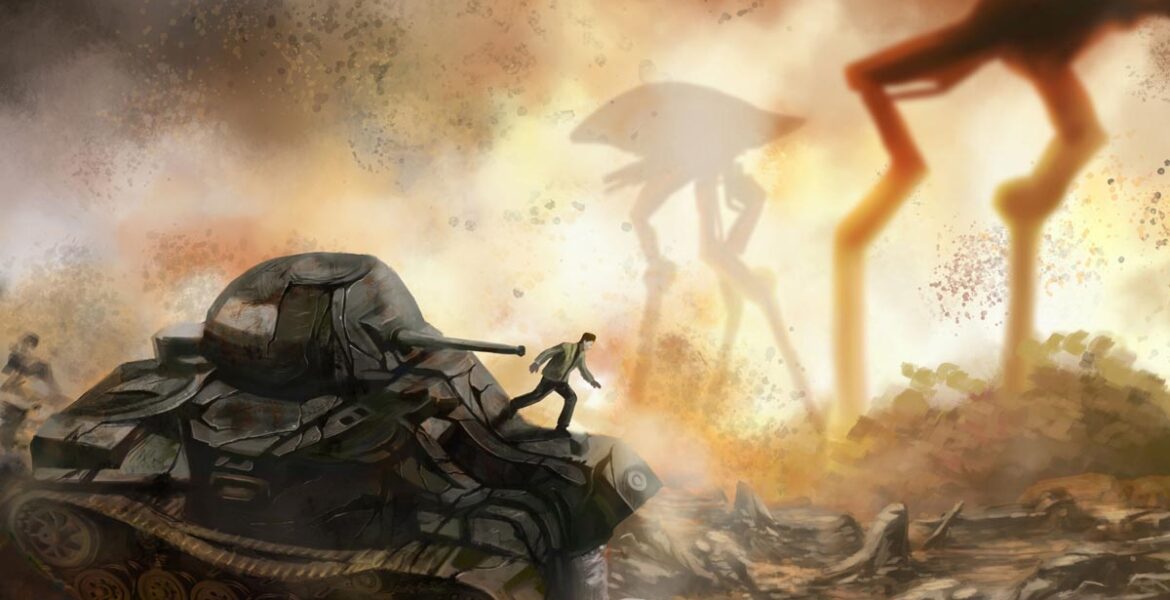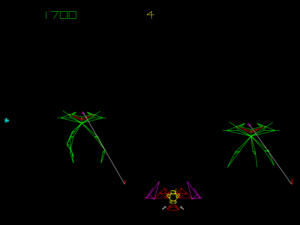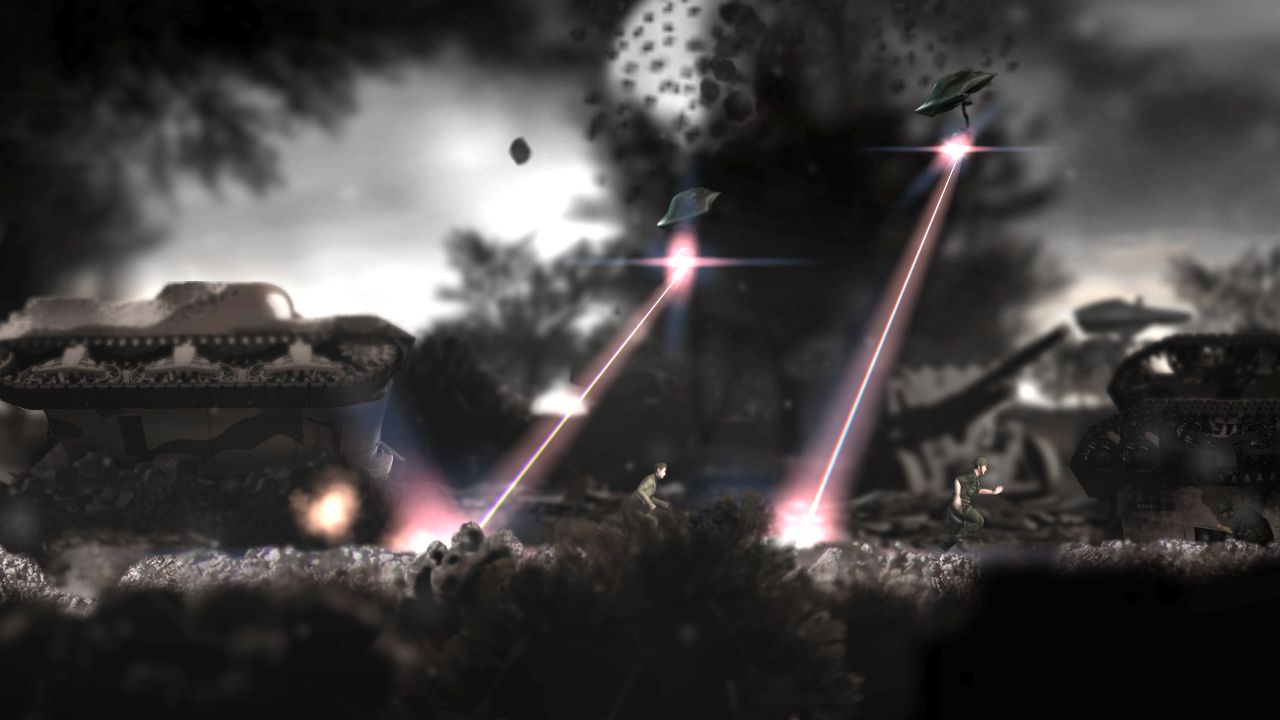
The War of the Worlds, as told by videogames
This is one of a few pieces on this site rescued from the digital scrapheap, originally published for a site that’s no longer online. I’ll begrudgingly remove if any shadowy publishing types compel me to relinquish what’s rightfully theirs, despite having unceremoniously binned it themselves, but come on. That’d just be silly.
It’s presented as is, so you’ll have to forgive any outdated references or generally shoddy writing.
–
When I first read H.G. Wells’ The War of the Worlds in high school, I hadn’t fully appreciated the weight of its influence. The 1897 novel, in which Martians land in the English county of Surrey, is widely credited as having popularised the invaders-from-Mars concept – this much I knew. But what that actually means, the sheer pervasiveness of it, has only dawned on me after years of seeing Wells’ inky fingerprints almost everywhere I look in popular culture.
This is especially true of videogames. Take the titular antagonists of 1978’s Space Invaders, whose enduringly classic design has become the symbol of an entire medium, and trace it back: “The alien design was inspired by The War of the Worlds,” said the game’s creator Tomohiro Nishikado. “In the story, the alien looked like an octopus. I drew a bitmap image based on the idea.”
One year after Space Invaders came another arcade game that wore this inspiration more proudly on its sleeve: Cinematronics’ War of the Worlds, which rendered in vector graphics the spindly three-legged ‘tripods’ that Wells so vividly described the Martians piloting. It’s a simple affair, the tripods skittering their way down the screen while the player tries to gun them down, but it was a visual spectacle back in 1979 and still looks great today.

But while it impressed with its graphics, Cinematronics’ arcade game was manufactured in very small numbers and never made a splash commercially. Compare its failure and descent into obscurity with the instant and enduring success of Space Invaders, and therein is the cruel contradiction: creators and audiences see something exciting in The War of the Worlds, but a game that pays overt homage will not necessarily shift units.
The next game to try came to ZX Spectrum in 1984, after London-based developer CRL nabbed the videogame rights for Jeff Wayne’s hit prog rock retelling of Wells’ novel. The result was a tedious and confusing game in which a stickman tours identical-looking towns on the Kent coast before either being zapped by a Martian or dying of hunger.
Few would argue that CRL’s effort was a good game, and the logic of licensing a music album for a game on a platform infamous for its poor sound was questionable in the extreme. It’s boring and frustrating, but in being so, it is also true to its source material in a way that no other game based on The War of the Worlds has dared to be. It’s easy to forget that, cool enemy design aside, there’s very little in Wells’ book that lends itself to a videogame. Much of it is given over to the narrator’s account of foraging for food and hiding from Martians in abandoned houses, characterising what he describes as “a sense of dethronement” of the human race.
“The problem with The War of the Worlds is that, if you follow the story of the book, it’s a guy pining for a couple of weeks,” Steve Sargent tells me. He would be the next individual to take a stab at Wells’ story in videogame form, 14 years later. “It’s a guy who’s basically walking around, avoiding being killed – which could be a fun game, I guess, but back then? Not really. We didn’t really have the technology to do something like that.”
Sargent was a Senior Producer at GT Interactive when the chance to work on a PC game based on The War of the Worlds came up, and he was immediately keen. “I lived fairly close to where all that is supposed to have happened in the book, I’d walked around Horsall Common and all that kind of stuff,” he recalls. “I was just very into it.”
Like the Spectrum game, this was to be licensed to the still-popular Jeff Wayne album. But Sargent and his team quickly decided that it would be necessary to play a little more fast-and-loose with the source material to make the game enjoyable, “massaging” elements of the original story and most notably extending the length of the invasion – as well as having another begin in Scotland – to make its vision of a war game viable.
The game, which Sargent describes as “a pain in the ass” to develop with a small team, was a highly ambitious real-time strategy title that had no set missions, but instead had players commanding either human or Martian armies – made up of 3D models; novel at the time – in a back-and-forth tussle for territory on a map of the UK. Jeff Wayne was heavily involved, signing off on everything, and his original music was remixed for the first time to better suit the tempo of a game.
It finally launched in 1998, a year late, and Sargent laments that it turned out “too difficult and too hardcore” to be a real success. As a mollycoddled modern player revisiting the game nearly 20 years on, it’s hard to disagree. The non-linear approach is appropriate for a story that lacks major flashpoints and heavily emphasises a kind of directionless chaos – the words ‘tumult’ and ‘tumultuous’ appear in the book no fewer than 27 times – but this is pretty much the only aspect of Wells’ novel that is represented by the game.
The original plan was for the game to also launch on PlayStation, but failed attempts to squeeze it onto Sony’s game disc required Sargent’s team to change tack. Another studio, Pixelogic, was eventually given the chance to develop an entirely different interpretation of The War of the Worlds for the system, using some of the PC version’s assets. The result was a vehicle combat game that again, has very little to do with Wells’ book, apart from featuring Martian tripods.
“It had almost no marketing put behind it,” says Sargent of the PlayStation release. “It didn’t even get a release in the US, as far as I remember.”
North America had also been a tricky market for the PC version. “We had a really nice box in the UK, which I think was a gatefold box with an embossed machine on the front,” Sargent recalls. “But the US cover was a piece of shit – they never really got The War of the Worlds there. It was one of the few territories where the album wasn’t a success, so they didn’t get it from that perspective, and they didn’t like Anglo-centric games back then in terms of geography.”

The War of the Worlds (Other Ocean, 2011)
It’s surprising, then, that the next and most recent game based on The War of the Worlds actually originated in the US, more than a decade later. Californian developer Other Ocean was given the opportunity to work with the license when friend of the studio Susan Cummings, then of Paramount, was looking to license some digital titles.
“They threw the idea our way, and we were like ‘yeah, that’s great!’” Other Ocean head of development Mike Mika tells me. “Then they told us what the budget would be and we were like, ‘oh, that’s not very good.'”
Despite this, Mika and his team were so enthused that they signed up to develop a digital Xbox 360 title based on The War of the Worlds – Wells’ original novel this time, not the movie or musical. But quickly, familiar issues around converting the story to the videogame medium began to emerge. “The book was way more challenging to adapt than we thought when we first started designing the project,” admits Mika. “There wasn’t much going on – we didn’t have a guy running around with a gun shooting at aliens the whole time. We wanted to stay true to that.”
Set on making the game a puzzle platformer, the Other Ocean team turned to the passions of their childhoods for inspiration. Flashback and Out of this World (Another World in Europe) were both particular touchstones for doing “a lot with very little” in terms of atmosphere building, with the studio even adopting the distinctive rotoscope animation technique used in those games. Nostalgia also played a key part in securing Patrick Stewart in the narrator role, with Wells’ novel having been a childhood favourite of the thespian’s.
Stewart’s monologues, written by British author Christopher Fowler and based heavily on lines and beats from the book, come closer to capturing the original’s doom-laden atmosphere than any game to date. But at the same time, it doesn’t feel as though puzzle platforming was the best way to complement them. Levels needed to be populated and obstacles created for the game to work, and Wells’ novel lacks obvious inspiration to this end. The result was the addition of small, spider-like Martians that frustrate rather than striking fear into one’s heart, and can be simply shaken off. With all the talk of humans being “nothing more than germs to be eradicated” in the eyes of the infinitely superior Martians, it jars.
After only six to seven months of development from a team of around eight people, War of the Worlds launched on Xbox Live Arcade in 2011. Even in the digital realm, the gulf in reactions between the US and the UK remained strong; Mika admits to having been shocked to receive “much more favourable reviews in Europe than we did in the US.” The IP and the setting were factors in this, of course, but he also points to the fact that the game’s chief sources of inspiration, Flashback and Out of this World, “have a pretty cemented history in Britain, but in the US were not as well received or as well-known.”
War of the Worlds wasn’t perfect, then, but Other Ocean had a pretty hefty update in the works alongside a planned PlayStation 3 port. This never saw the light of day, with the plug being pulled on the project before it could be released. Worse, the game wound up being delisted from Xbox Live and is now utterly inaccessible – moreso than an arcade game that launched more than thirty years earlier.
“We’ve worked on a lot of games, from Street Fighter to Minecraft – a lot of original and a lot of classic games – but any given month, we get more fan mail for War of the Worlds than any other game we’ve worked on,” reveals Mika. “That makes it even more bittersweet.”
“Just being able to be part of that was exciting for us,” he goes on. “It’s funny, because as a franchise you’d expect it to be much larger… We’ll have design meetings for other games where this book comes up a lot. H.G. Wells was such an influence, so it’s weird that it’s not as big as it should be.”
Well, yes and no. Perhaps it is strange that those adapting The War of the Worlds for videogames have had so little luck, given that its influence in the games industry and beyond is so significant. But on the other hand, is it really such a surprise that a book about human obsolescence and our increasingly half-hearted whimpers of protest doesn’t easily make for a blockbuster videogame – particularly within the more established genres?
Right now, what seemed utterly infeasible to Steve Sargent back in 1998 – a game simply about surviving, with no combat – is probably the best way to go for a developer that wants to make a serious attempt at an interactive War of the Worlds. Until then, the lesson from history would be to leave well alone.
Editor’s note: Cinematronics’ War of the Worlds arcade game is accessible in emulation form, should you choose to seek it out. Other Ocean’s demo version for its 2011 game is also still available on Xbox Live, though the full game is not.
